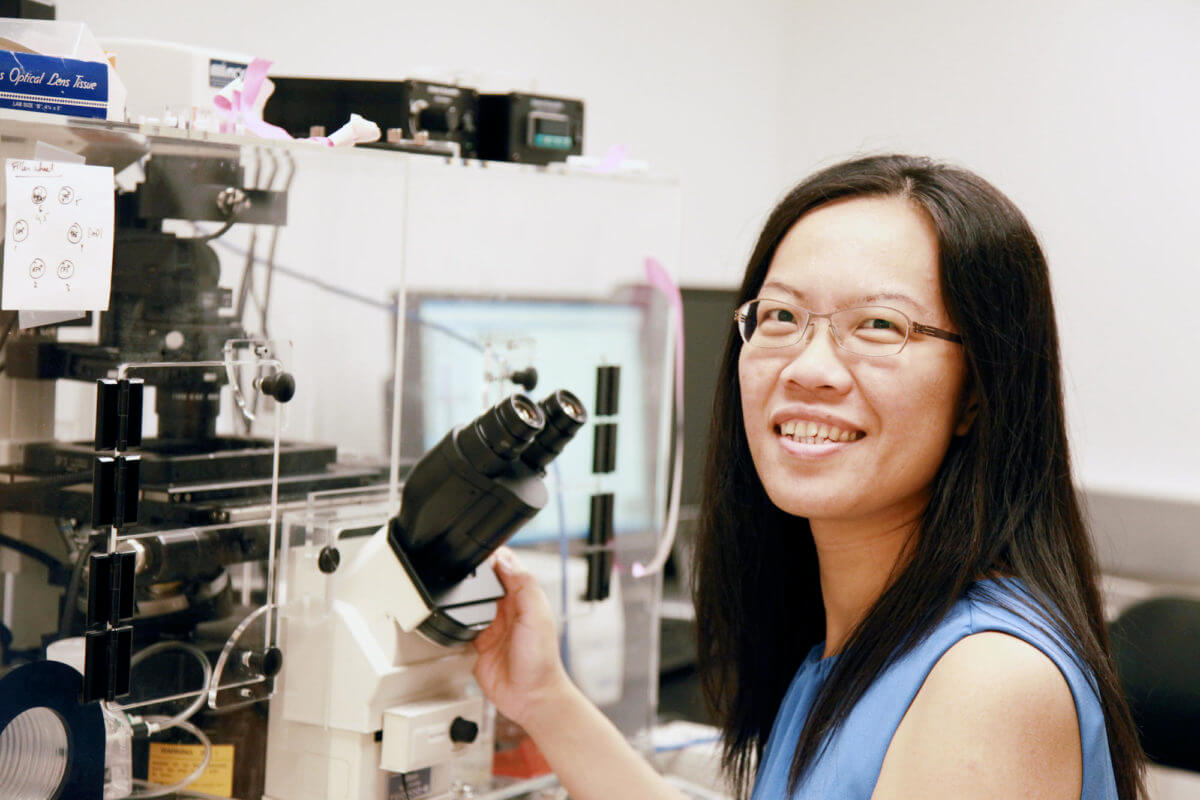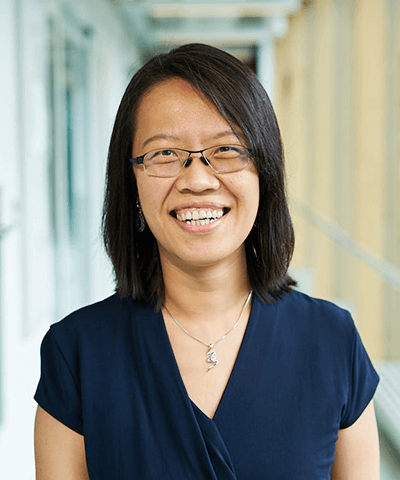
The diversity of science is a big part of what makes it function, with people of all backgrounds, experience, and skill sets working together to solve problems. Nowhere is this more apparent than the laboratory of Ya-Chieh Hsu, the newly named Alvin and Esta Star Associate Professor of Stem Cell and Regenerative Biology.
Hsu’s research goal is to figure out how cell-cell interactions enable development, regeneration, and repair using skin as a model. But for her, running a productive lab is about much more than good scientific ideas — it requires understanding the strength and needs of each individual in the lab, and creating a collaborative and supportive atmosphere where both people and ideas can flourish.
Communication is the key

Hsu studies the largest organ of the body: the skin.
“Skin protects us from infections and dehydration. It also enables thermoregulation and a wide variety of sensations,” says Hsu. “All of these functions involve a lot of different types of cells.”
From layers of skin tissue to hair follicles to nerves, a diverse set of components makes up the skin. Hsu is investigating a fundamental question: “How do the different types of tissues communicate with each other to enable the growth and regeneration of a fully functional organ?”
As a developmental biologist, Hsu could have picked any organ to study. Hsu chose to focus on the skin because of the diverse cell types that reside in this organ and the astounding regeneration ability seen in several skin cell types.
“The skin contains a wide variety of cell types, including several populations of stem cells responsible for renewing different tissues — the epidermis, the hair follicle, and the melanocyte,” explains Hsu. “The behavior of these stem cells is heavily influenced by their neighboring cells: nerves, immune cells, muscle, blood vessels, dermal fibroblasts — you name it.
The skin is also subjected to various insults, including injuries and infections, and provides us a unique opportunity to compare cell-cell interactions during homeostasis and injury repair. What we learn from that could be instrumental for finding ways to manipulate stem cells under disease conditions, such as chemotherapy-induced hair loss, chronic non-healing wounds, and burns.”
But there is an element of beauty in Hsu’s choice, too: “I just love how these cells look. The epithelial tissues, the neuronal connections in the skin — it is just an amazing sight.”
Starting a lab at HSCRB
When Hsu joined the Harvard Department of Stem Cell and Regenerative Biology (HSCRB) in the summer of 2014, she received a warm welcome from her colleagues and future collaborators.
“This department has been a wonderful place to start my lab,” she says. “I benefit a lot from the open culture of the department and the active interactions between labs and between colleagues. Everyone has slightly different perspectives, different questions, and different reasons that drive their research — but we are connected by the same passion to do exciting research and we all share a natural gravity towards challenges.”
“We both study organs that naturally regenerate — I study the blood and she studies the skin — so we often bounce ideas off each other,” relates David Scadden, a fellow HSCRB faculty member.
Hsu’s research fills an important niche in the department. “Many faculty in the department work on different organs which have epithelial tissue, but it’s hard to study it in those contexts,” says Scadden. “The skin is a great model for studying the epithelium.”
“Her research into skin conditions such as wound healing is part of our mission to do research that treats diseases and improves human health,” he adds.
Mentoring matters

When Hsu started to build her lab, her focus expanded beyond the research to the people doing it.
“Before, I observed a lot about data,” she reflects. “Now, I observe a lot more about the people in the lab, how they operate, and what they are good at.
I have had a lot of wonderful mentors when I was a trainee, and I have always wanted to pay it forward. I realized that although the commitment individual trainees should be the same, the way to mentor each person should be tailored to their specific needs. I spend time interacting with and understanding everyone. This way, I can match people to the right research projects, and nurture them to grow in their own way to achieve things they have not thought of before.”
Bing Zhang was the first postdoctoral fellow to join Hsu’s lab. His doctoral training was in biochemistry, which focuses on molecules rather than cells and tissues. But Hsu saw the potential for him to explore a new direction.
“I noticed that although he had never worked with tissues, he is very observant and has the exceptional ability to connect dots that may not be obvious to others,” recalls Hsu. “When he looked at sections of tissue under the microscope, he not only focused on the original measurement he had in mind, but also picked up incidental characteristics that could lead to other answers — and many times, even more exciting directions than the original one.”
Because of this, Hsu supported Zhang’s research in tissue biology to give him the opportunity to develop new skills.
For his part, Zhang was surprised when Hsu invited him to join her lab. “My Ph.D. had nothing to do with her research, but somehow this worked out,” he says. “She’s really provided me with a lot of different opportunities that are very exciting.”
“You can’t imagine how much time she puts into every one of us — the postdocs, the graduate students, the undergrads,” Zhang continues. “She really spends a lot of time interacting with us.”
Making time to help
Meryem Gonzalez-Celeiro, the first graduate student in Hsu’s lab, agrees that Hsu’s commitment to working with lab members when they need it makes a big difference.
When Gonzalez-Celeiro had to prepare a presentation for the Harvard Stem Cell Institute’s annual retreat in May — a scientific meeting with over 300 researchers packing the auditorium — she was nervous and unsure. Hsu helped her think through and practice her presentation. Gonzalez-Celeiro ultimately won the grand prize for best trainee presentation.
Hsu’s mentoring is not limited to lab work. “She takes time to know your interests and ambitions to make sure that you’re happy and motivated, but also makes sure that you’re thinking about your future and what your next steps should be,” says Gonzalez-Celeiro.
The power of collaboration

As much as Hsu dedicates time to individual lab members, she also pays attention to how they work together.
“Individuals need to have ownership of their work, so my lab members are each in charge of their own projects.” says Hsu. “But the projects need to be interconnected in a certain way, so that there is synergy in the lab. During lab meetings, everyone should be able to provide input from a slightly different perspective, even if it’s not about their direct projects.”
Hsu also encourages collaborations: “There are projects in my lab where two people figure out that working together allows them to achieve much more than what they can do alone. Science has become much more collaborative, and collaborations within as well as between labs have really opened up exciting research opportunities for us.”
A hair-raising collaboration
One such joint project is between Gonzalez-Celeiro and postdoctoral fellow Yulia Shwartz. They study the arrector pili muscle, which is located in the hair follicle and produces goosebumps when it contracts.
“How do different cell types in the skin influence the hair follicle stem cells? That’s the question I’m really interested in,” says Gonzalez-Celeiro. “I study the arrector pili muscle because it’s in close proximity to the stem cells, but my collaborator focuses on the mechanics of nerves. This collaboration turned out to be one of our best moves — it makes the work much more fun and efficient. We’ve both gained a lot from this experience.”
According to Zhang, such smooth-running collaborations are no coincidence, rather the product of Hsu’s careful scientific matchmaking. When he applied to the lab, he was interviewed by everyone, from the lab manager to the undergraduate students.
“It was a little bit surprising at first, but I actually found that it’s very useful,” he says. “It’s really about the atmosphere that we create together, with the right people.”
Expanding the lab
Hsu is deeply proud of how much her lab members have grown as scientists since she started her lab at Harvard.
“All of the exciting science that we are doing now is because of the effort they’ve put into building the projects over the past few years,” says Hsu. “I think it’s more of their achievement rather than my own. I’m just very proud of them — how they’ve become mature scientists through the process, and how they’ve helped each other throughout the journey.”
“I am also a huge fan and advocate for curiosity-driven research,” she says. “My lab is full of curious minds that are interested in figuring out how things work.”
Looking ahead, Hsu says the time is right to increase the research capacity of her lab. “At this moment, I think we are ready to grow in size — the first generation of people have become capable mentors, and their projects are in good shape,” she says. “We have more projects than people now, and we are fortunate to have received additional research support. We are highly interested in recruiting new graduate students and postdocs.”
Whatever happens, Hsu is staying focused on her scientific passion.
“I’m not tired of looking at skin yet. There are still a lot of mysteries, and it’s still one of the best organs to address the questions that we are interested in. It is simply a privilege to be a scientist.”
